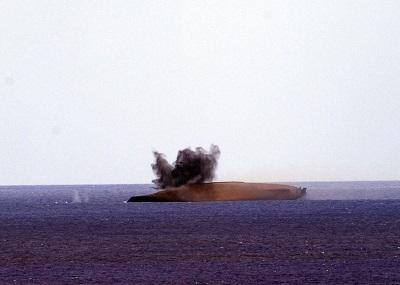Transport of Target Vessels for Ocean Disposal
In 1977, EPA issued a general permit under the Marine Protection, Research and Sanctuaries Act (MPRSA) to the U.S. Navy for the transport for ocean disposal of target vessels used in the U.S. Navy’s Sink Exercise (SINKEX) Program.
Why is this permit needed?
The SINKEX Program uses ex-Navy vessels as targets for at-sea live-fire exercises. The United States views these exercises as essential for training personnel and testing military equipment. Ex-vessels used in SINKEX are not recovered after sinking in deep ocean waters. The general permit authorizes the U.S. Navy to transport target vessels from the United States (or from any other location) for the purpose of sinking such Navy's ex-Acadia being used for SINKEX.
Navy's ex-Acadia being used for SINKEX.
vessels in deep ocean waters to test ordnance and provide related data.
Because the target vessels remain on the ocean floor after sinking, there are permit requirements that apply to the Navy’s preparation of vessels and sinking locations.
Since 2010, the Navy has sunk between 0- 4 vessels per year.
What are the permit requirements?
The U.S. Navy prepares vessels for SINKEX in accordance with the MPRSA general permit at 40 CFR 229.2, including as interpreted in a subsequent document captioned “Determination by EPA and Agreement between Navy and EPA” (January 2014). The MPRSA general permit for the transport of target vessels (SINKEX permit) requires that:
- before sinking, appropriate measures are taken by qualified personnel at Navy or other certified facility to remove to the maximum extent practicable all materials which may degrade the marine environment, including without limitation:
- emptying and flushing of all fuel tanks and fuel lines to the lowest point practicable so that the tanks and lines are essentially free of petroleum; and
- removing from the hulls other pollutants and all readily detachable material capable of creating debris or contributing to chemical pollution;
- all target vessels are sunk at least 50 nautical miles from land and at depths of at least 6,000 feet;
- necessary measures are taken to ensure that the vessel sinks to the bottom rapidly and permanently, and that marine navigation is not otherwise impaired by the sunk vessel; and
- Navy provides an annual report to EPA with the name of each vessel used as a target vessel, its approximate tonnage, and the location and date of sinking.
What does the 2014 Determination and Agreement say?
In 2014, EPA determined that additional clarification of the MPRSA general permit requirements will ensure the continued protection of human health and the environment, and that additional clarification of the permit’s requirement will provide greater transparency regarding SINKEX vessel preparation.
The January 2014 document clarifies EPA’s interpretation of the MPRSA permit, identifies Navy’s specific agreements related to SINKEX vessel preparation and removal of materials that may contain polychlorinated biphenyls (PCBs), and enhances reporting to improve confidence, accountability, and transparency in verifying PCB removal from SINKEX vessels prior to sinking. The clarifications are important because PCBs may be present in certain solid materials on the older vessels used in SINKEX. Potential shipboard materials that could contain PCBs include, but are not limited to, bulkhead insulation, wire and cable insulations, and felt and rubber gaskets.
